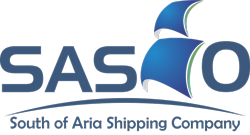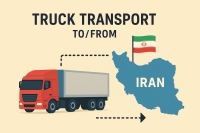Key Routes for International Truck Transport To/From Iran
1. North–South Transport Corridor (INSTC)
A major multimodal transit network that spans approximately 7,200 km, linking India, Iran, Azerbaijan, Russia, and Northern Europe. It integrates sea, rail, and road transport to efficiently move goods between South Asia and Northern Europe, significantly reducing transit times compared to traditional sea routes via the Suez Canal.
Within Iran, key components include roads and rail lines connecting Bandar Abbas or Chabahar ports to cities like Tehran, Baku, and beyond
infrastructure projects such as the Astara (Iran–Azerbaijan) railway link and the Rasht–Astara connection are critical to completing this corridor.
2. East–West Corridor (Silk Road / BRI Route)
East–West Corridor is a part of the historic Silk Road and China's Belt and Road Initiative, this corridor facilitates freight transport from China and Central Asia, through Iran, toward the Caucasus, Turkey, and Europe
Key border crossings like Dogharoun, Sarakhs, and Bazargan provide flexible entry and exit points, making it ideal for truck routes Iran–CIS and beyond, ensuring seamless road freight movement.
3. South–West Transport Corridor
The Persian Gulf–Black Sea corridor, a vital Iran transit corridor, stretches from Persian Gulf ports like Bandar Abbas and Chabahar through northern Iran to Azerbaijan, Georgia, and Eastern Europe (Ukraine, Romania, Bulgaria). This route slashes transit times from 35–37 days via Suez to just 10–12 days, offering a faster solution for truck shipment from/to Iran and enhancing cost-effective trucking to Iran.
4. Ashgabat Agreement Corridor
The Ashgabat Corridor is an international transport and transit route that connects Central Asian countries (Turkmenistan, Uzbekistan, and Kazakhstan) through Iran to Turkey and Europe, as well as to Iran’s southern ports such as Bandar Abbas and Chabahar, and the Arab states. This corridor plays a vital role in facilitating trade and cargo transport between Asia and Europe.
5. Pan-Asian Highway (AH8)
Part of the Asian Highway Network, Asian Highway 8 (AH8) runs about 4,900 km from Torfyanovka in Russia down to Bandar-e Emam Khomeini in Iran. It traverses major cities in Russia and facilitates overland cargo movement into southern Iran.
These Iran transit corridors make truck transport to/from Iran a strategic choice for global logistics, combining speed, cost-efficiency, and connectivity.
Critical Border Crossings for Truck Transport to/from Iran
Iran’s strategic border crossings are essential for efficient truck transport to/from Iran, connecting Asia, the Middle East, and Europe. These points facilitate seamless cargo movement across regions.
- North/Northeast: Sarakhs and Lotfabad
Sarakhs and Lotfabad in northeastern Iran are key for connections to Turkmenistan and Central Asia, supporting road and rail logistics. - East: Dogharoun
Dogharoun serves as a vital gateway to Afghanistan, Tajikistan, and Uzbekistan, enabling smooth cargo transport. - West: Bazargan, Nordooz, Astara, and Bileh Savar
Bazargan (Iran–Turkey) links to Europe, while Nordooz (Iran–Armenia) and Astara/Bileh Savar (Iran–Azerbaijan) support routes to the Caucasus. - Southeast: Mirjaveh
Mirjaveh connects truck transport to/from Iran with Pakistan, facilitating trade with South Asia via road networks.
These crossings ensure reliable and efficient cargo movement, making Iran a pivotal hub for regional logistics.
Goods Commonly Moved by Iran Trunking
Below are the main types of goods moved via truck transport to/from Iran through its transit corridors.
- Agricultural Exports: Pistachios, dates, and saffron are transported to Central Asia, Turkey, and Europe via borders like Bazargan and Sarakhs, often in refrigerated trucks.
- Industrial Goods: Machinery, automotive parts, and steel are shipped to the Caucasus, Iraq, and Afghanistan through crossings like Dogharoun and Astara.
- Consumer Products: Textiles, electronics, and cosmetics are moved to neighboring countries, leveraging Iran’s role in corridors like the North-South Corridor.
- Oil and Chemical Products: Refined fuels and chemicals are transported in tankers to Turkey and Central Asia, using secure routes like Mirjaveh.
- Transit Cargo: Goods like cotton and appliances from Asia to Europe pass through Iran via the East-West Corridor, utilizing efficient border points.
Key Benefits of Truck Transport To/From Iran
Truck transport to/from Iran provides businesses with a fast, flexible, and cost-effective solution for regional and international trade.
One of the main advantages is speed and reliability. Trucks often deliver faster than sea or rail, particularly for full or partial loads. Flexibility is another benefit, as Iran’s extensive road network allows access to destinations not connected by ports or rail, supporting door-to-door delivery and specialized handling for high-value or sensitive goods.
Cost-effectiveness is also key. For shorter distances or smaller shipments, truck shipment from/to Iran can be more economical than maritime alternatives, with reduced packaging needs and competitive pricing.
Overall, truck transport to/from Iran offers a versatile, reliable, and strategic option for businesses seeking timely, flexible, and cost-efficient logistics solutions in the region.
When to Choose Truck Transport To/From Iran
Truck transport to and from Iran is recommended for shipments where speed and flexibility are a priority, especially over shorter distances or when reaching destinations not easily accessible by other modes. While ocean freight is generally more cost-effective for large volumes over long distances (as highlighted by Maersk), trucking provides quicker transit times and better accessibility for specific routes within Iran and neighboring countries.
Truck transport is recommended when :
- Shorter distances: For shipments within Iran or nearby countries, trucks are often faster than rail or ocean transport.
- Door-to-door delivery: Greater flexibility in reaching locations without direct rail or port access.
- High-value or perishable goods: Ideal when speed and careful handling are critical.
- Specific requirements: Specialized equipment or handling needs that trucks can accommodate.
- Partial or less-than-truckload (LTL): More economical when shipment volumes don’t fill a full truck.
When truck transport may not be the best option:
- Large volumes over long distances: Ocean freight is usually cheaper for bulk shipments.
- Highly cost-sensitive shipments: Rail or sea transport may be more budget-friendly.
Law of Transit of Foreign Goods through the Territory of Islamic Republic of Iran
Iran’s law on the transport and transit of foreign goods provides a comprehensive framework for international trucking and road freight operations. Below are the key practical points for truck transport to/from Iran:
Container and Customs Exemption
Containers are considered cargo vessels and are exempt from customs duties and taxes. When containers enter Iran with their original seals, no inspection of contents is required, and transit is permitted as long as documents match and additional seals are attached. In exceptional cases where suspicion arises, containers may be opened and inspected under the supervision of customs officials.
TIR-Covered Trucks
Trucks carrying TIR carnets do not need to provide extra documentation for transit within Iran. For trucks without TIR coverage, a written commitment from a licensed Iranian transport company is sufficient for legal transit.
Routes and Control
The Transport and Terminals Organization, in coordination with the Ministry of Interior, designates specific road transit routes, while the Iranian Police (NAJA) monitors and enforces controls along these corridors.
For full details and practical guidance, download the complete PDF of the The Law of Transit of Foreign Goods through the Territory of Islamic Republic of Iran -it’s your essential reference for smooth operations.
Essential Documents for Truck Transit of Foreign Goods via Iran
For smooth and legal truck transport to/from Iran, the following documents are generally required:
- Transit Permit (Form 110) – Authorizes the movement of goods through Iran.
- Customs Declaration – Details the nature, quantity, and destination of the cargo.
- Bill of Lading / Road Transport Document – Confirms shipment details and serves as a receipt.
- Commercial Invoice – Shows the value and description of goods.
- Packing List – Specifies contents, weight, and dimensions of packages.
- Certificate of Origin – Confirms where goods were manufactured.
- Guarantee Letter – Ensures compliance with transit regulations and potential duties.
- Insurance Policy – Covers cargo for loss or damage during transit.
- Driver Credentials – Passport, visa, International Driving Permit, and health certificate.
- Company Authorization – Confirms the driver is legally representing the transport company.
Truck Transport To/From Iran plays a key role in connecting the Middle East, Central Asia, and Europe. With its strategic location and major transit corridors like North–South, East–West, and Ashgabat, Iran offers fast, flexible, and cost-effective trucking solutions. For reliable and professional services, SASCO, as one of the best freight forwarders in Iran, provides comprehensive road freight, TIR-compliant shipments, and expert handling, ensuring smooth, timely, and legally compliant transport of goods to and from Iran.







